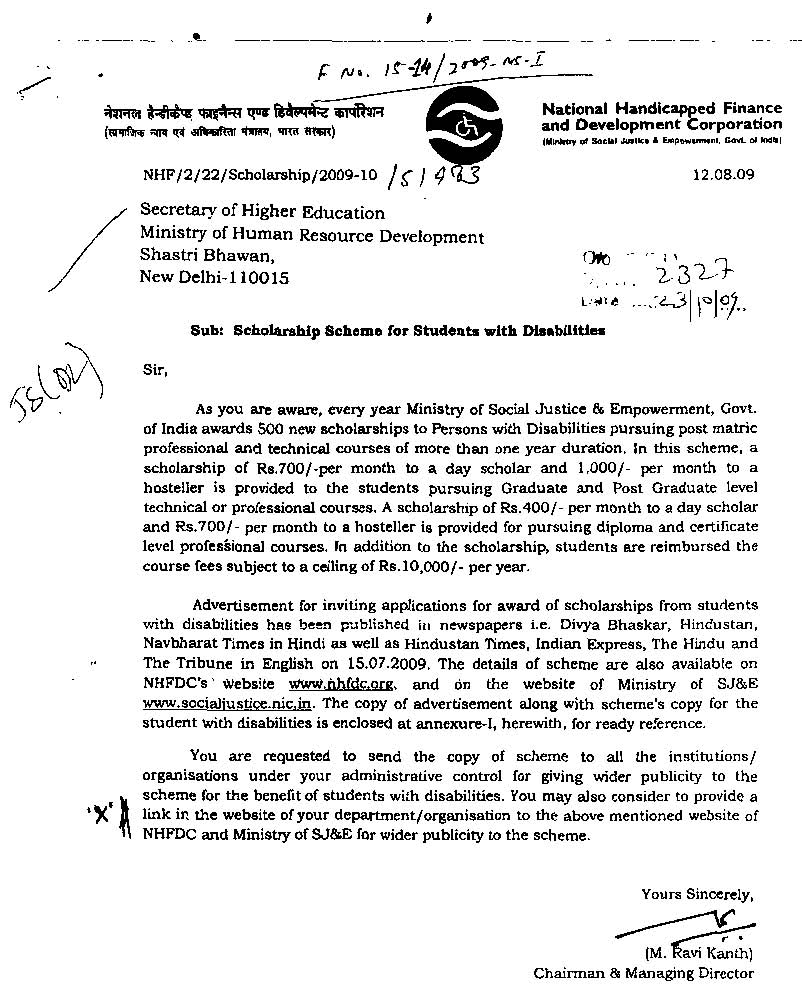Following is from http://pib.nic.in/release/release.asp?relid=54585.
LOK SABHA
The National Sample Survey (NSS) data for 2004-05, indicates rural-urban disparities, gender disparities, inter caste disparities, imbalances in access opportunities for tribal population of the country, disparities amongst religious groups and differences in enrolment rates between the poor and non-poor. The Gross Enrolment Ratio (GER) in higher education for the nation as a whole as a percentage of the population cohort in the age group of 18-24 years is 12.4% based on 2007 enrolment data whereas the GER in secondary education (class XI-XII) as a percentage of the population in the age group of 16-18 years is 28.96% based on data reported in Selected Educational Statistics of 2006-07.
During the Eleventh Plan establishment of Central Universities in hitherto uncovered States has been envisaged. 15 New Central Universities have been notified on 15.1.2009 and another Central University has been established in Jammu Division of the State of Jammu and Kashmir. The Indira Gandhi National Tribal University (IGNTU) has been established for facilitating and promoting studies in areas concerned with the way of life of the tribal population in the country. A new Regional Centre of the IGNTU has been inaugurated in Manipur. University Grants Commission (UGC) has invited detailed project proposals from State Governments for Establishment of 374 model degree colleges in the districts having GER lower than national level with the Centre-State funding in the ratio of 1:1 for Special Category States and 1:2 for other States. The Eleventh Plan has schemes for incentivizing State Government for setting up of new institutions or expansion of existing institutions with Central assistance with focus on underserved areas, strengthening colleges and State universities with focus on underserved areas which are not presently eligible for receiving assistance from UGC to enable these institutions to fulfil the criteria for UGC assistance, additional assistance to State universities and colleges which are already declared fit to receive grants under Section 12B of the UGC Act. The All India Council for Technical Education (AICTE) has permitted second shift in certain engineering colleges and polytechnics. Expansion of intake in Central Educational Institutions by 54% has been undertaken consequent to the implementation of the Central Educational Institutions (Reservation in Admission) Act, 2006. A scheme of interest subsidy during moratorium period for students accessing educational loans for technical and professional education has been notified on 8.9.2009.
This information was given by the Minister of State for Human Resource Development Smt. D. Purandeswari, in a written reply to a question, in the Lok Sabha today.
MV/Hb
November 25th, 2009
Following is from Today’s Dharitri.
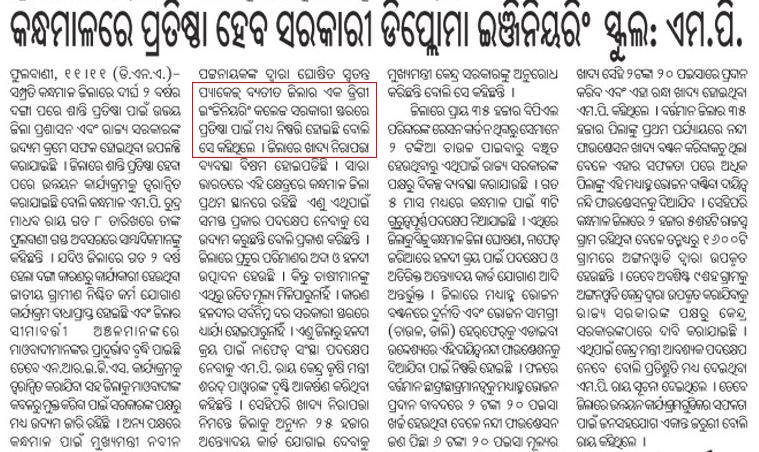
November 12th, 2009
Following is from the page http://www.dheorissa.in/DHE/Initiatives.aspx?lnk=ini.
To popularise Science education in backward areas Government has decided to open Colleges in the the districts of Malkangiri and Nuapada. Three more Government +2 Science Colleges at Kutra (Sundargarh), Tiring (Mayurbhanj) and Jirang ( Gajapati) are going to be esablished.
November 12th, 2009
Following is from http://www.ficci.com/events/20009/ISP/richard.pdf.
Minister SibaI, Mr. Singhani, Mr. Mittal, Dr. Mitra, distinguished guests:
It is a great pleasure to be with you this morning, and an honor to have the opportunity to address this distinguished audience, filled as it is with a diverse and accomplished group of leaders from across India. I thank you for the opportunity.
Over the next two days, you will hear about many of the most pressing issues facing higher education in India, issues that are also challenging universities in the United States and across the globe: reforming regulation and accreditation; using technology; ensuring afford ability; and promoting publicprivate cooperation. All of these issues present opportunities to improve our universities and further the good work they do in society.
It is an honor to have with us today the Union Minister for Human Resource Development, Kapil Sibal.
Only a week ago, Minister Sibal visited Yale, and I was pleased to learn about his ambitious vision for higher education in India. He has shown intrepid leadership in fashioning the Ministry’s plans for new world-class universities, and for making the challenge of improving India’s higher education system a national priority.
There is no doubt that India possesses a number of educational institutions that have made their mark, and will continue to make their mark, on the world stage. The Indian Institutes of Technology, the Indian Institute of Science, and the Indian Institutes of Management are among these. But the rise of this country to become one of world’s economic powerhouses begs for expansion in India’s higher education system. The need is a striking one. India is already the world’s largest democracy. In two decades, it will be the most populated country in the planet, and by 2050, it is likely to become the second largest economy in the world.
We hear much about today’s "knowledge economy,” and for good reason: it is the innovation born at the world’s great universities – and the leaders who are trained there – that will drive the economic growth and continued prosperity of India and the world’s other leading economies in the coming decades.
With this in mind, Minister Sibal and the Indian government have rightly set the dual goals of increasing access to higher education and creating a group of new, worldclass universities. Today, only 12 percent of college-age Indian students pursue higher education. By contrast, in the United States, 63 percent of students go to college; among the 30 member countries of the Organisation for Economic Co-operation and Development, the average is 56 percent. Minister Sibal has articulated an ambitious target of 30 percent of Indian students pursuing higher education by 2020.
Increasing access will require the expansion of enrollment at existing institutions and the creation of many new ones at all levels. The new world-class universities will only contribute a small fraction of the required increase in enrollments throughout India, but they will play an especially prominent role in India’s future development.
First, however, these universities must be built, and that is what I will speak about today: the challenge of building world-class universities.
A great research university is not built from the bricks and mortar of its campus, but of the students and scholars who inhabit it, and the discourse and ideas they share. A university exists not for the purpose of handing out diplomas to those who go through its doors, but to advance knowledge and to educate young people to become critical thinkers and society’s leaders. Building a world-class university is far more than a construction project – it is building a community of knowledge, far more than it is building a campus. A world-class university avails its students not just of courses of study, but of an environment that facilitates learning and growth in all areas of human endeavor. The university is composed of many things: a distinguished and engaged faculty; broad library and museum collections; state-of-the-art laboratories and computing resources; and a wide range of extracurricular, cultural and athletic activities, to name just a few essential components.
At the most fundamental level, a world-class university contributes to the world in three ways: through research, through education, and through institutional citizenship.
First, by facilitating advancements in science, technology, and medicine, research universities help spur economic prosperity and the advancement in the health and quality of life in communities across the world.
Second, by educating students, great universities prepare the next generation of leaders, leaders who will be able to tackle new problems and new situations with maturity and flexibility and who see the world with curiosity and an open mind.
Third, by acting as models of institutional citizenship, world-class universities contribute to the betterment of society and instill in their students social responsibility and an appreciation of service to their communities.
Let me discuss each role of the university in turn.
Inspiring innovation
First and foremost, a world-class university must have a world-class faculty. This serves as the backbone of any institution. For a broad, comprehensive university to be considered world-class it must have a faculty that, through its research, is making significant contributions to the advancement of knowledge.
In our "knowledge economy," nations prosper by virtue of their capacity to innovate – to develop and introduce new products, processes, services, and even, new ways of thinking. The extent to which such innovation happens is a function of the continuing advance of science.
As the principal source of basic research, comprehensive universities playa fundamental and irreplaceable role in encouraging economic development and national competitiveness. This basic research is motivated by the quest for intellectual discovery, not some practical objective-but in the long run, it is the wellspring for all commercially oriented research and development. That fact, that fundamental research occurs within the university – rather than in government laboratories, non-teaching research institutes, or private industry – is an essential element of allowing a university to realize its full potential. When researchers are isolated in research institutes, students – especially undergraduates are deprived of exposure to first-rate scientists, their methods, and their research. Absent the best scientists, the quality of teaching will suffer, and the curriculum is less likely to include the most novel thinking and innovative approaches.
World-class research requires substantial resources, and it is important to allocate these resources to produce maximum social benefit. This is one area where America has far outstripped the rest of the world, by allocating its public funding for research not by seniority and not by political give-and-take, but through the strict meritocracy of peer review. India would be well advised to adopt this model.
The research undertaken in universities must not stay in the academic buildings and laboratories where it is born. To drive national innovation, it must move from theory to practice, and the university plays a key role in this process as well. Engagement with industry is a central function of the modem research university, as commercializing faculty inventions benefits both the university and the broader
society.
Training future leaders
Second, just as faculty members contribute, through their scholarship and research, to the intellectual vigor of their nation and the world, they also serve to shape the future leaders of their nation and, again, the world.
The phrase "the knowledge economy" that is so often spoken about would seem to suggest that universities impart to young people what is most obvious – that is, knowledge. But the best universities do not practice the mere transfer of knowledge from teacher to student. They focus not on the mastery of content, but on the development of their students’ capacity for independent, critical thinking.
Universities exist to teach young people how to think, not what to think. The best American universities seek to educate undergraduates not to be experts in a particular field, but to be creative, flexible, and adaptive; to approach problems critically and to collaborate with others to solve them; and to be able to understand different cultures and adapt to new environments. Universities like Yale train undergraduates not for a profession, but for life.
The method of education employed by America’s most selective universities what we know as the "liberal education" of undergraduates – is particularly well suited to preparing students to enter the rapidly-changing modem world. Courses are not principally about a student mastering a body of knowledge, but about that student’s mind being stretched. This must be a guiding light in the creation of a course of study: as many classes as possible should be small, small enough to take shape as active discussions, not as lectures passively attended. Students must be challenged not to memorize, but to analyze. Professors must serve as mentors, as sources of inspiration, not merely as lecturers and graders.
Students, too, should not find their development limited to the classroom. Students at Yale often say that they learn more over meals with their peers in university dining halls than they do in classrooms and lecture halls. In addition, extracurricular activities- producing a play, singing in an a cappella group, writing for a campus publication – help teach skills in teamwork, communication, and collaboration that students later put to use as their careers develop.
Bettering society
Third, a world-class university leads by example, both in its local community and in the-world. Acts of institutional citizenship have benefits on two levels: they represent a positive force for human welfare, and they also inspire students to embrace social responsibility in their own lives. To illustrate this point, I will give examples of institutional citizenship both locally and globally.
When I became Yale’s president in 1993, the city of New Haven had a distinctly negative external image. As soon as I took office, we created a comprehensive strategy to engage with our surrounding community, partnering with public officials and neighborhood groups to better the city in which we live. Our initiatives included an internship program to allow students to work in schools, community service organizations, and local government; a Homebuyer Program to subsidize home purchases by our faculty and staff in neighborhoods around the campus; a concerted effort to spin-off Yale research into commercial ventures, particularly in biotechnology and medicine, and a major investment in the redevelopment of the downtown retail district. As a result of these actions, our community has been dramatically strengthened.
On a more global scale, consider the issue of reducing carbon emissions. The problem of global warming requires a multinational solution, and no solution will succeed without the cooperation of the United States and India. But universities can and should – play an important role in the effort to curtail global warming, both in their research and in setting standards for their own carbon emissions. In 2005, Yale made a commitment to reduce carbon emissions to 10 percent below our 1990 level by the year 2020, which equates to a 43 percent reduction in our 2005 carbon footprint. If the nations of the world were to negotiate such a reduction in carbon emissions later this year at their meeting in Copenhagen, the planet would be much better off.
Of course, we acknowledge that even the most ambitious sustainability efforts at the world’s universities will not have a measurable impact on global carbon emissions. But in keeping with our mission as a teaching institution, we seek to inspire our students and lead by example. And I believe that the collective leadership of the world’s universities on this important issue may very well serve, over time, to make meaningful global cooperation more likely.
Conclusion
There is no doubt that expanding access to higher education in India is an imperative, and Minister Sibal and others should be commended for understanding its importance. Expanding access to higher education will raise the general standard of living and create avenues of upward mobility for the most disadvantaged. With adequate investment of resources, expanding access is an achievable objective; it has been done before, in Europe and Japan following the second World War, and in China within the last eleven years.
But building world-class universities is a Herculean task. It has never been done before in one concerted effort, by one country. And it requires more than money. But if India succeeds, the impact on Indian society and its aspirations to world leadership will be limitless. It is through world-class universities that the seeds of innovation are planted arid the next generation of leaders acquires the capacity to lead. As this dream is pursued, it will be important to ensure that even these elite universities are accessible and affordable, and not merely available to those whose families can pay for it.
The challenge is immense, but the potential gains are commensurate with the challenge. Through their research, teaching, and institutional citizenship, a new set of great universities will strengthen this society, and the people of India – and of the rest of the world – will reap the benefits.
November 9th, 2009
Following is a letter that Dr. Karmee has sent to many people. This is an excellent work. It is well researched and based on something unique to the location, the Gandhamardan Hills of Baragarh and Balangir. (Considering that many in Orissa may not be aware of Gandhamardan Hills being in Orissa and/or its medicinal values, I have a companion piece on it at https://www.orissalinks.com/orissagrowth/archives/2776.)
I hope others will also focus on unique aspects and attributes of other parts of orissa and write to the higher education task force (HETF) about it.
Respected Mr. Patnaik, CM of Odisha and Members of the Higher Education Task force,
I appreciate the formation of higher education task force by the state government. Also, I am hopeful that such innovative steps will definitely sharpen the higher education of Odisha.
Sirs,
I would like to request the higher education task force to recommend the establishment of a “National Institute of Ayurveda” in Gandhamardan area in western Odisha. I am sure many of us are aware of the potential of Gandhamardan mountain and medicinal plants in it.
In this document, I am presenting the details about the “Gamdhamardan mountain as a reservoir of medicinal plants” with scientific references; thereby, making a case for the establishment of a National Institute of Ayurveda.
I am sure our respected CM, who is the author of the “Garden of Life: An introduction to the Healing Plants of India” will take this matter seriously. Also, I am hopeful that the higher education task force will take the necessary steps; so that, “the medicinal plants in Gamdhamardan mountain” will not get lost with time.
Please have a look on the following write-up for further details.
Thanking you with best regards,
Sanjib
1. “National Institute of Ayurveda” is a must in Gandhamardan area: Introduction and Analysis:
Gandhamardan mountain range is known world wide as a reservoir for medicinal plants. It is located in the western Odisha. More specifically, it is located in between Balangir and Bargarh district (Figure 1).
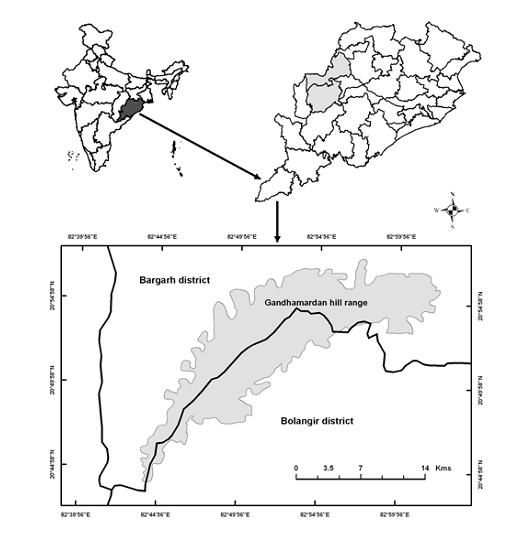
Figure 1 Map showing location of Gandgmardan mountain in between Balangir and Bargarh district
Many eminent scholars of life sciences have done a lot of research on the medicinal plants available in this mountain range. In fact, this hill range is legendary. It has found a place in folklore and mythology -of how Hanuman plucked Bisalyakarani, a medicinal plant, from this hill to save the life of Laxman in the battle of Lanka in “The Ramayana”. In addition, it is known to the whole world how this hill range was at the centre of one of the most prominent ecological movements, that is, the battle between environmentalists keen on protecting aryurvedic plants and the then state-owned Bharat Aluminium Corporation.
Apart from this, there are many scientific journals and books that are mentioning about the potential of medicinal plants available in Gandhamardan mountain (see the reference list)1-5. The state/central govt must establish a “National Institute of Ayurveda” in this place. Right now, both Balangir and Bargarh (Paikmal) each have one Ayurvedic College. Establishing a national level institute on Ayurvedic Medicine will help to a great extent to these colleges by carrying out research in emerging areas. Recently, research on ayurvedic medicine is attracting considerable attention in India and abroad.
It is important to note that, significant developments have boosted systematic research on different aspects of ayurveda and traditional medicine in India. They include the Golden Triangle project jointly managed by CSIR, ICMR and AYUSH; the New Millennium Indian Technology Leadership Initiative (NMITLI) of CSIR and various schemes of DST and DBT.
Additionally, ayurveda is also entering to the mainstream “Drug Discovery”. Following graph show the growing demand of research on Ayurvedic medicine.
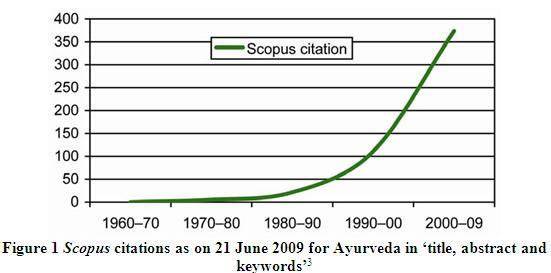
In addition to this, a paper by “Reddy and Pattnaik” from the Forestry and Ecology Division, National Remote Sensing Centre, Hyderabad 500 037, Andhra Pradesh, India points out many interesting facts about “Gandhamardan hill” 4.
It states that, after analyzing and studying the plant resources of Gandhamardan hill range a total of 912 vascular species belonging to 556 genera under 142 families were found. Herbs dominate the flora followed by trees, climbers and shrubs.
Therefore, proper conservation and management plans are needed to save the natural resources, especially medicinal plants, of this sacred hill range. Many botanists fear that this reserve of medicinal plants could be lost in the next few years if proper care is not taken and the indiscriminate collection and smuggling of herbs by local villagers is not stopped. The state forest department which is supposed to guard this botanical wealth is not able to do enough to stop all these developments because they lack of the knowledge and expertise about these plants. In fact, they have no clue which are useful medicinal plants and which are not.
In addition, in these places there is no organized way of farming of the medicinal plants. They just grow in the wild. Therefore, it is very difficult to guard these species. Taking the advantage of this situation any villages or smugglers can walk into the forest and collect the herbs. It is very important that the government should takes steps to grow these plants, harvest these properly, and finally do the marketing of these medicinal plants and herbs in a well organized manner. It should take care of the cultivation and preservation of these plants like it is doing for other forest products like sal seeds or kendu leaves etc.
However, intellectually this problem can be solved by establishment of a National Institute of Ayurveda. The above discussion/ description/ scientific observation strongly suggests the establishment of a National Institute of Ayurveda near Gandhamardan mountain.
2. Following are some of my points in support of establishing a National Institute of Ayurveda in Gandhamardan area:
* West is very much keen on establishing institute on ayurveda. One such successful institution is the National Institute of Ayurvedic Medicine established by Dr. Scott Gerson, USA, (http://niam.com/corp-web/index.htm). This is an example of an institute that has carried out research into Ayurvedic practices to a great extent. In this context, we must use our native expertise. In addition, the National Institute of Ayurvedic Medicine, USA can be a collaborative partner for establishing an institute Gandhamardan area.
* This mountain is very important to all of us and to the world. We should use our natural medicinal resources very judiciously. It is also very surprising that no steps have been taken for the preservation of these high-valued plants. It is the right time to establish a National Institute of Ayurveda in this area.
* As we know this mountain range is a reserve for medicinal plants. Therefore, it will provide adequate environment for cutting edge research/studies in different areas of ayurvedic medicine per international standard.
* Establishment of a National Institute of Ayurveda will help for organized way of farming the medicinal plants; which just grow in the wild. This will also help in preserving different rare species of plants.
* This Institute will provide a boost to the ongoing research/academic activities by Ayurvedic College Balangir and Shri Nrusinghanath Ayurved College Paikmal, Bargarh on this area. Along this line, establishing a National Institute of Ayurveda will make this place a leader in this area of science in national/international level.
* This step will attract companies like Dabur, Ayur, and others to set-up labs/companies in this area.
* From the above discussion it is very clear that research fundings are already available from the leading agencies of India like CSIR (Council for Scientific and Industrial Research), DST (Department of Science & Technology), and DBT (Department of Biotechnology). So, there will be no problem in setting up labs and developing infrastructure.
* There is a lot of synergistic research going on between Ayurvedic, Homeopathic and Allopathic branches of medicine. This is very clear from our day-to-day life as Allopathic doctors often prescribe medicines of Dabur, Neem, etc. Therefore, establishment of such an institute will further enhance the research between this National Institute of Ayurveda with other institutes viz. VSS Medical College, SCB Medical College etc. of the state.
3. The following steps need to be taken to establish a National Institute of Ayurveda in Gandhamardan
* It is important to look in to the web-site of these model Institutes viz. National Institute of Ayurvedic Medicine, USA (http://niam.com/corp-web/index.htm); Gujarat Ayurved University Jamnagar, Gujrat, India (www.ayurveduniversity.com); Rajasthan Ayurved University, Jodhpur Rajasthan (http://www.raujodhpur.org/aboutus.html); National Institute of Ayurved, Jaipur, Rajasthan (http://nia.nic.in/); Ayurvedic university, Hoshiarpur, Punjab; (http://www.financialexpress.com/news/punjab-clears-first-ayurvedic-university-in-hoshiarpur/517911/; This seems to be a new Institute).
* Immediately, the state govt. should present a proposal to the HRD Ministry for establishing National Institute of Ayurveda in Gandhmardan area.
* Along the line of the above institutes, the state govt. in collaboration with govt. of India must establish a National Institute of Ayurveda in Gandhamardan area.
References:
1. Netra Bhanu Pradhan, Gandhamardan – A treasure House of Medical Plants, Navaratna Journal, Jan-Feb, 2008, 41-44.
2. Ayurveda: scientific research and publications, Current Science, 2009, 97( 8), 1117-1122
3. C. Sudhakar Reddy and Chiranjibi Pattanaik, An Assessment of Floristic Diversity of Gandhamardan Hill range, Orissa, India. Bangladesh J. Plant Taxon. 16(1): 29-36, 2009
4. Following are some of the research papers taken from the reference list of the paper 3 (Papers only with the name Gandhamardan are taken)
Brahmam, M. and Saxena, H.O. 1990. Ethnobotany of Gandhamardan hills – Some noteworthy folk medicinal uses. Ethnobotany 2: 71-79.
Brahmam, M. and Saxena, H.O.1990. Phyto-chemical screening of the plants of Gandhamardan hills of Orissa (India) for tannins, saponins, flavonoids and alkaloids. Asian J. Plant Sci. 1: 71-79.
Misra, R.C. 2004. Therapeutic uses of some seeds among the tribals of Gandhamardan hill range, Orissa.Indian J. Traditional Knowledge 3: 105-115.
Misra, R.C. and Behera, G. 1998. Ecological status of Gandhamardan forests using remote sensing techniques. In: Biodiversity Conservation: Problems and Prospects. Proc. National Seminar on Biodiversity Conservation, Bhubaneswar, India, pp. 75-80.
Misra, R.C. and Das, P. 1998. Vegetation status of Nrusinghanath – Harishankar complex, Orissa. J. Econ.Taxon. Bot. 22: 547-554.
Mishra, R.C. and Das, P. 2003. Wild poisonous seeds: Some notable species from Gandhamardan Hill ranges of Orissa. J. Econ. Bot. 27: 513-518.
Misra, R.C. and Das, P. 2004. Vegetation stratification of Gandhamardan hill range, Orissa using remote sensing techniques. J. Econ. Taxon. Bot. 28: 429-438.
Mishra, R.C., Panda, P.C. and Das, P. 1994. Lesser known medicinal uses of plants among the tribals of Gandhamardan hill ranges, Orissa. In: Gupta, B.K. (ed.), Higher Plants of Indian Subcontinent, Vol. III, Bishen Singh Mahendra Pal Singh Publications, Dehra Dun, India, pp. 135-142.
Mishra, R.C., Panda, P.C. and Das, P. 2001. A taxonomic study of the ferns and fern allies of Gandhamardan hills, Orissa. J. Econ. Taxon. Bot. 25: 577-590.
Panigrahi, G. 1963. Gandhamardan Parbat, Orissa – A potential source of important indigenous drugs. Bull. Reg. Res. Lab. 1: 111-116.
Pattanaik, C. and Reddy, C.S. 2007. Medicinal plant resources of Gandhamardan hill range, Orissa: An urgent need for conservation. Natl. Acad. Sci. Lett. 30: 35-38.
Raju, D.C.S. 1960. Vegetation pattern of Gandhamardan hills. Bull. Int. Soc. Trop. Ecol. 1: 21-22.
Saxena, H.O. and Brahmam, M. 1995. Vascular flora of Gandhamardan hills. J. Econ. Taxon. Bot. 19: 113-132.
5. NOTE: This is not the complete list of references. Because of time limitation I have collected as much as I can.
November 4th, 2009
IISc Bangalore faculty Prof. Abi has a nice article on this in the IIT Kharagpur student magazine Scholar’s avenue. Following are some excerpts arranged as bullet points.
- Salary: Going by the present, post-SPC salaries, you’ll start as an assistant professor at Rs. 6 lakhs, at the end of your career, you’ll be at over 12 lakhs.
- ‘benefits’: allowances (house rent, transport, telephone and internet), social security contributions (pension or provident funds, career-end bonus, etc) and perks (medical insurance, leave travel concession, for example). The value of these benefits could easily exceed 50 percent of the salary.
- consulting: It can give you the satisfaction of solving some real world problems. It can be a great source of ideas for long term research. Most importantly, it also has the highly desirable property of giving you some extra cash!
- IIX salary is not only fully protected, it’ll also (a) keep up with inflation, (b) keep rising (through annual increments) and (c) see substantial jumps every decade or so. To sweeten things even more, IITs are planning to introduce incentives to reward extraordinary performance (and I’m sure other IIXs will follow suit).
- As an IIX faculty member, you’ll enjoy a couple of features that are not available to engineers and managers in industry (in both public and public sectors): two (or even three) months off every summer and a one-year sabbatical leave every seven years.
- As an IIX faculty member — and this may come as a surprise to you — you’ll also enjoy certain advantages over faculty in US universities.
- First, you don’t have to pay your graduate students, the government pays them.
- More importantly, the same research idea has a far higher probability of getting funded in India than in the US. This means that you’ll spend more of your time on actually doing research, than on writing grant applications seeking that ever-elusive funding.
- Finally, the autonomy, the choice and the flexibility: As an IIX faculty member, you’ll probably spend 30 to 40 percent of your time in teaching and related activities. The remaining time is yours, and yours alone — nobody tells you how to spend it. You could use it for research (for getting peer recognition), teaching (for your students’ adulation), and consulting (for money, and collaboration with industrial partners). There are other academic pursuits as well: writing books and popular science articles, teaching kids in local schools and colleges, learning about new and emerging fields, etc.
November 2nd, 2009
Following is an excerpt from a report in expressbuzz.com.
The Centre has sanctioned funds for establishment of Government polytechnics in 14 districts of the State.
Each of the institutes will receive a one time grant of Rs 12.30 crore from the Centre for infrastructure development while the State Government will take care of the recurring expenditure, including staff salary and administrative expenses.
The Government polytechnics will be located in districts having no such institutes.
Orissa has 13 technical institutes including three women polytechnics offering diploma courses in various trades. However, these institutes are limited to only nine districts and most of them are located in coastal region.
The new polytechnics will be opened in seven Naxal-affected districts of Malkangiri, Nabarangpur, Gajapati, Sambalpur, Jajpur, Nayagarh and Deogarh.
The other districts selected for the Centrally assisted technical institutes are Boudh, Nuapada, Kalahandi, Kendrapara, Jagatsinghpur, Puri and Sonepur.
Sites for the proposed polytechnics have been selected in respective district headquarters.
The Government will provide at least 10 acres of land for each of the polytechnics free of cost.
The new polytechnics will start functioning from the next academic session. …
According to a conservative estimate, each polytechnic will have at least 50 staff. The Government will take a decision on recruitment of staff on permanent or contractual basis.
The Government had already submitted a proposal to the Centre for financial assistance for opening Government polytechnics in the remaining seven districts.
October 29th, 2009
Following is an excerpt from a report in India Journal.
The government of India is planning to establish 10,000 Industrial Training Institutes (ITIs) in rural areas across the country for imparting technical training to youths.
Minister of State for Planning V Narayanasamy announced this while inaugurating the first national convention of rural institutes, organized by the National Council of Rural Institutes, here Oct 19.
“We have opened the flood gates for foreign investment in the education sector. Our thrust is on expanding the educational infrastructure in the rural areas by opening more institutes and universities,” the minister said.
He said plans were afoot to set up one rural university in each backward and tribal clusters across the country. Besides, 25,000 schools would also be set up in rural areas under the Public-Private Partnership mode.
Some of the existing Rural Universities in India are:
Looking for the "New Education Policy of the Nation reflects the principles evolved here in developing the rural university concept " I came across the document at http://www.ncri.in/html/english%20finacial%20guidlines.pdf which mentions this policy, but this policy was made in 1986 and revised in 1992. There is no mention of "Rural Universities" in the 11th plan. I guess the minster’s staement above may be referring to the upcoming 12th plan. If that is the case, it is a great idea to pursue it now.
If indeed as the minsiter says, a rural university is established in each backward and tribal clusters across the country Orissa could go after at least 3 such universities: one in the KBK district cluster, one in the Gajapati-Kandhamal district cluster and one in Sundergarh-Mayurbhanj-Keonjhar district cluster. In this regard we must watch out the pages of the National Council of Rural Institutes.
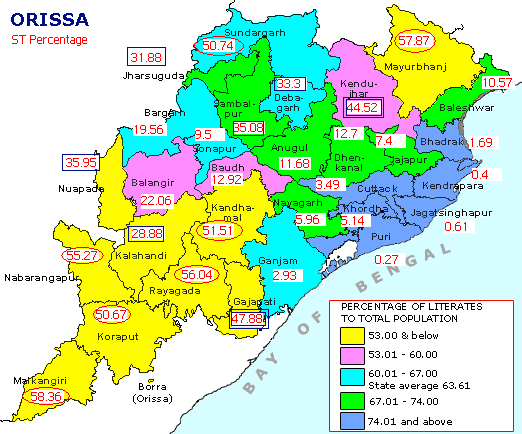
October 23rd, 2009
Our sister site in Twitter is http://twitter.com/orissalinks. (Often when we are busy or do not feel like writing a full posting here, we post a micro-blog in our Twitter sister site. The Twitter sister site also automatically adds the headline from this site and the orissagrowth site. Once in a while we will collect those headlines here. But readers wanting a broader and more immediate coverage should consider following our Twitter site at http://twitter.com/orissalinks.) Following are some selected items from that site between August 20th and October 20th 2009.
- IGNOU to start 5 vocational training and educational programs in Kandhamal, Orissa.
- IIIT Bhubaneswar inaugurated. Article mentions an Entrepreneurship Development Inst. having been established. Where?
- Max Phd prod in US between 99 & 03: Berkeley 2175, Seoul nanl U 1655, Nanl Taiwan U 1190, & Beijing Univ 1153.
- Indian Inst of Legal Metrology (IILM) at Ranchi, Ahmedabad, Bhubaneswar, Bangalore & Faridabad have microbalance m/c. The microbalance m/cs can be used to detect forged signatures. They can detect exact wt of objects of relatively small mass like a signature.
- India needs more civil engineers. IIT Bhubaneswar only new IIT to offer it. Kudos to Prof. Acharya for his foresight.
- 2009 World Bank Rept: Secondary education in India : universalizing opportunity. pdf Vol 1 Vol 2
- Ravenshaw University, Cuttack, Orissa to have a department and programs in disability studies.
- RT @ Rugby in Orissa Nice article about Rugby in KISS, Bhubaneswar.
- Orissa CM asks for more SAI Centres in tribal districts like Koraput, Malkangiri, Keonjhar, Sundergarh and Mayurbhanj.
- Prof. Anil Gupta, of National Innovation Foundation mentions about a herbal fruit ripener from Orissa to ripen bananas.
- Kapil Sibal: Will set up 1,000 polytechs, and make them quality institutions; community colleges that give diplomas.
- The recent (Sept 10) AIIMS Bhubaneswar tender document is at
- Orissa govt’s plan for PPP based medical colleges in Balasore, Rayagada and Naraj may be related to GOI initiatives.
- Health Ministry: PPP to upgrade district hospitals to medical colleges will be allowed in NE states, hilly states and backward states.
- Health Ministry: New medical colleges in metros to go vertical. Min required land reduced from 25 to 10 acres.
- Health ministry: Out of the 6 AIIMS-like institutes, 4 in Bhubaneswar, Jodhpur, Patna and Rishikesh have got clearance.
- HRD minister Kapil Sibal proposes a National Higher Education Finance Corporation (NHEFC) to finance higher education.
- CRRI Cuttack ( ) scientists have crossed soft rice (komal saul ) with high yielding rice and obtained a hybrid.
- North Orissa University, Baripada awards 368 PG, 26 M.Phil and 6 Ph.D degrees this yr. More such univs needed.
- Qualcomm & Premji Fndn to provide wireless broadbnd to schools. Pilot: 40 in Gujarat, Karnataka, & Rajasthan.
- NIFT will have a 10 acre campus in Chandrasekharpur, Bhubaneswar. Classes to start in temporary digs in Jan-Feb.
- Nice op-ed by IIMA Prof. T T Ram Mohan on why IITs and IIMs need not immediately broaden to full-fledged universities.
- Kapil Sibal while inaugurating CUO Koraput Centre keen to setup international standard educational institutions via PPP
- Kapil Sibal Companies shd setup such institutes to help students pursue higher studies in India instead of going abroad
- Sam Pitroda in : we need to expand more colleges, more universities, more research programs, more teachers, …
- Sam Pitroda in : Overall expansion requires not only participation from government, but also from the private sector.
- Prince dance group plan to open a dance academy in . Samaja reports that CM will give 1 cr for that.
- In Lanjigarh, Kalahandi (Orissa) Vedanta Resources runs a public school in partnership with DAV.
- Vedanta University Project adds 139 to take the total number of students it sponsors for studying in DAV school to 414.
- Central MOS Srikant Jena unsuccessful in convincing central gov. for a medical college in Balasore. At least he tried.
October 22nd, 2009
Continuing on our previous article at https://www.orissalinks.com/archives/3103 following is a table of the mega projects that are stuck. The delay costs the companies 100s of crores per year. If the various companies sincerely contribute to the human resource development of the state something similar to what is suggested by Kalahandi MP Bhakta Das (Expressbuzz Oct 17) in the context of Vedanta and the activists/opposers in the various places take a sensible approach then that will be a win-win situation for every body.
(However, one has to be careful in what they demand and how they demand. For example, laws should not be broken when demanding. Also, what is demanded should pass the common-sense test as making outrageous demands does not help. Nor does it help when it is not clear who the company is dealing with. The demands should be in tune with the size of the mineral resources to be used by the company and the environmental impact of the company.)
| Company |
Location |
Land Required (acres) |
Investment (in crores)
|
Current major Contributions by the company CSR arm or by its promoters in their individual capacity
|
Other contributions of the group; HRD contributions they should do |
| Vedanta |
Lanjigarh, Kalahandi |
2279 |
8400 |
Planned 15,000 crores Vedanta University in Puri with a personal donation of 5000 crores by Mr. Anil Agarwal;
DAV international school in Lanjigarh and supporting students in DAV Puri.
Burn and Trauma care center in Bhubaneswar has been announced.
|
MP Bhakta Das asks: 5 KVs, 5 tech colleges like Medical college, Engg College, Polytech, and ITI. |
| Vedanta |
Jharsuguda |
3350 |
(included above) |
100 bed hospital at Jharsuguda has been announced.
Supporting students in DAV Jharsuguda.
|
|
| Vedanta (Sterlite Iron & Steel) |
Keonjhar |
3400 |
12,500 |
Ditto |
|
| Tata Steel |
Kalinganagar |
3500 |
18,700 |
NTTF Gopalpur; NTTF Kalinganagar, Cost of Building of Inst of Math and applications (14 crores) , and small peanuts here and there.
Contributed 1 Crore to new XIM academic block.
200 bed hospital in Kalinganagar at the cost of 30 crores has just been announced.
|
50-50 partner with L & T in Dhamara port;
Planning an SEZ in Gopalpur.
|
| POSCO |
Paradip |
6000 |
51,000 |
not much |
|
| Arcelor Mittal |
Keonjhar |
8000 |
40,000 |
not much |
|
| Jindal Thermal |
Angul |
1100 |
5940 |
not much |
|
| Jindal Steel & Power |
Kalinganagar |
5750 |
13135 |
|
|
| Bhusan Power & Steel |
Kalinganagar |
1800 |
3500 |
|
|
| Uttam Galva Steel |
Keonjhar |
2150 |
8987 |
|
|
| Welspun Power & Steel |
Bhadrakh |
2200 |
6103.8 |
|
|
| Aditya Aluminum |
Rayagada |
5209 |
14,000 |
|
|
| Aditya Aluminum |
Sambalpur |
(included above) |
(included above) |
|
|
| Essar Steel |
Paradip |
2500 |
10721 |
|
|
| Essel Energy |
|
1600 |
7667 |
|
|
Public Sector companies that use Orissa’s mines and/or pollute Orissa otherwise:
| Companies |
Locations |
Latest profit figures |
Current major contributions |
HRD contributions they should do |
| NALCO |
Angul, Damanjodi (Koraput) |
|
|
|
| NTPC |
Talcher |
|
|
|
| SAIL |
Rourkela |
|
|
|
| MCL |
Sambalpur, Talcher |
|
Promised a medical college in Talcher |
|
Big Miners from Orissa:
| Companies |
Locations |
Mines details |
Latest Profit figures |
Current major contributions |
HRD contributions they should do |
| Essel Mining (Aditya Birla group) |
Joda – Barbil |
Iron ore; Will last another 24 years. |
892 crores in 2007-08 |
Not much |
|
| Tata Steel |
Iron ore – Joda
Chromite – Sukinda
Mnaganese and Dolomite
|
|
|
See the first table in this article.
See also this letter; and list.
|
|
| |
|
|
|
|
|
October 18th, 2009
The following table is from a Current science article by G. Prathap and B. M. Gupta. It gives a ranking of top 25 universities in India in term of their publications. The detailed methodology of the ranking is discussed in the above mentioned article. The same authors earlier ranked the engineering and technological institutes which we discussed here.
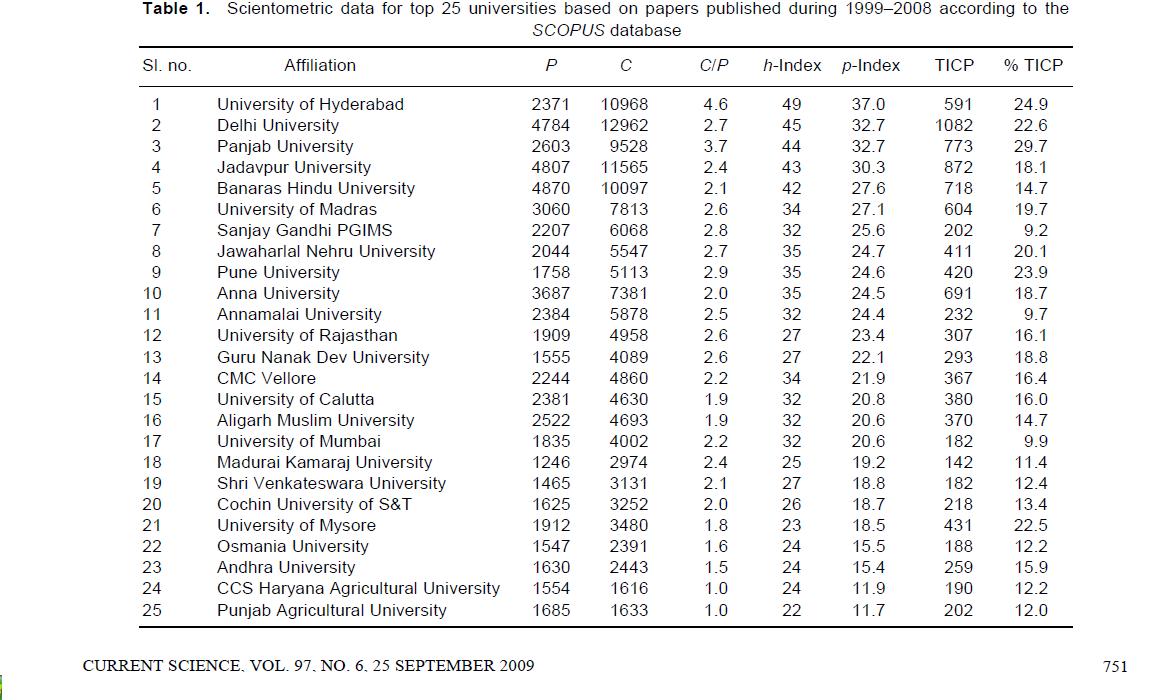
October 1st, 2009
Following is an excerpt from a blog entry of Professor Giridhar Madras of IISc Bangalore.
… According to the table, for an assistant professor on contract i.e., with no postdoc experience, it would start at 37,000 + accommodation. A regular assistant professor will get 52,000 + accommodation and will move to 62,000 + accommodation after three years. In addition, they are other benefits. This includes telephone allowance, academic allowances, children education allowance, subsidy for single girl child, leave travel concession for the whole family every year,medical benefits to the family, travel money for attending conferences etc.
In addition, one can get fellowships that vary from Rs 60,000 to Rs 6 lakhs per year from DST/DBT, depending on the fellowships. Faculty can go abroad during the three month vacation every year and get paid in international currency. One can take sabbatical for one year every six years and get paid at both places. In addition, one can earn considerably from consultancy from industry (or even government labs) depending on the area they work in.
The blog has more details and pointers to more details on what the IIXs should do to get a clearer picture out to prospective faculty.
September 27th, 2009
Following is an excerpt from a press release of Orissa’s Resident Commissioner in Delhi.
New Delhi
September 24, 2009
Chief Minister meets Union Minister for Tribal Affairs
Shri Naveen Patnaik, Chief Minister, Orissa met Shri Kanti Lal Bhuria, Union Minister for Tribal Affairs at New Delhi today and discussed about issues relating to tribal welfare in Orissa.
…
The Chief Minister also asked for release of Rs.140 crores during 2009-2010 for construction of 400 new 100 bedded ST Girls Hostels in the State. The Chief Minister requested that a Tribal University be set up in the Kondhamal district in Orissa. The Chief Minister requested for grant of Rs 5 crores for modernisation of the existing small Tribal Museum at Bhubaneswar and separate fund for opening of Tribal Museums in all the 17 Micro Project Areas in the State. He highlighted the need for increase in the amount of Post Matric Scholarship for ST/SC Students.
Recalling his recent letter written to the Union Minister, the Chief Minister asked for sanction of more Ekalabya Model Residential Schools (EMRS) in the 4 uncovered KBK districts i.e., Nuapada, Malkangiri, Sonepur & Bolangir in the current academic session.
September 25th, 2009
Thanks to tathya.in for the pointer. The Department of Higher Education web page is at http://www.dheorissa.in/DHE/Scholarship_Schemes.aspx. Following links are from that web page.
Scholarship Schemes of State & Central Government for 2009-10
The image of the advertisement is given below.
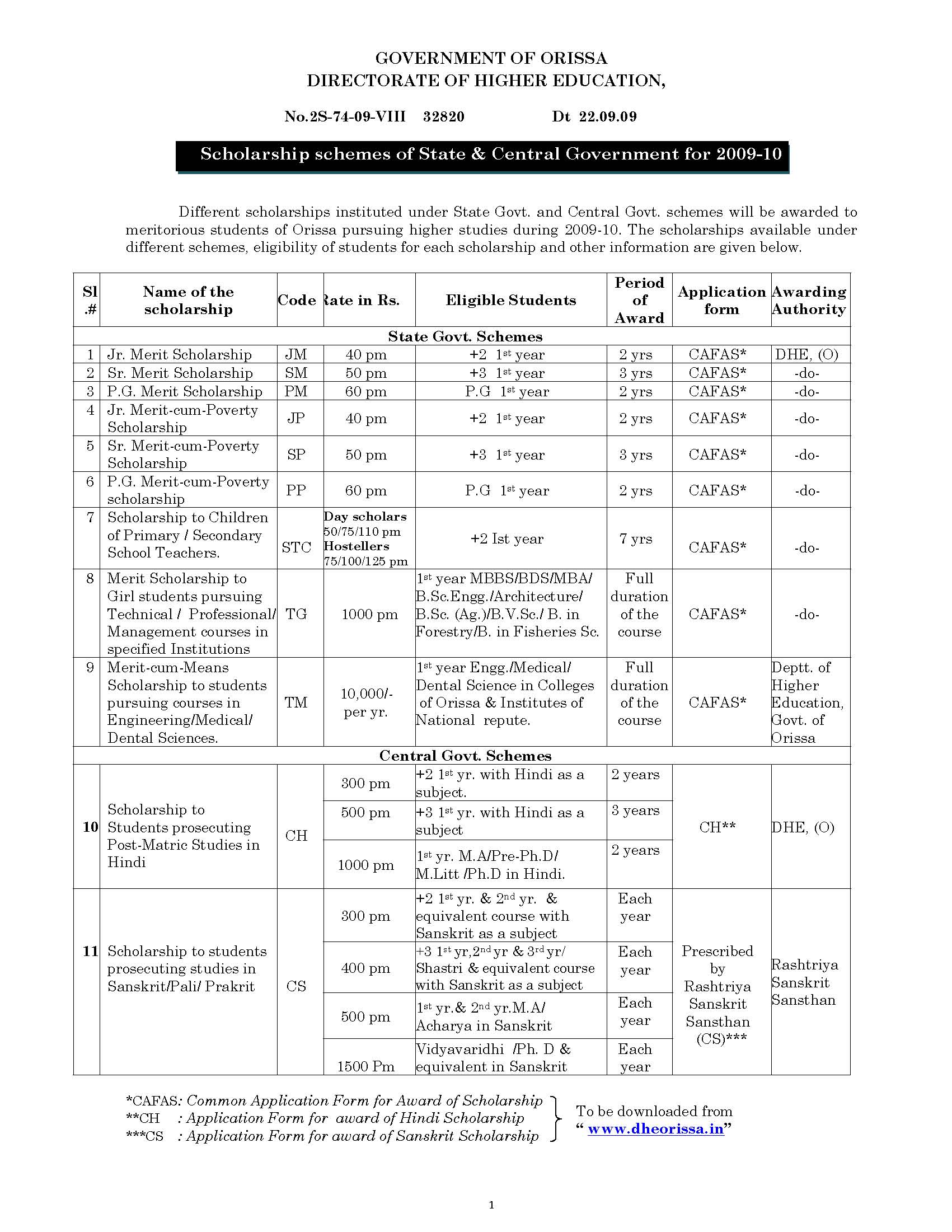
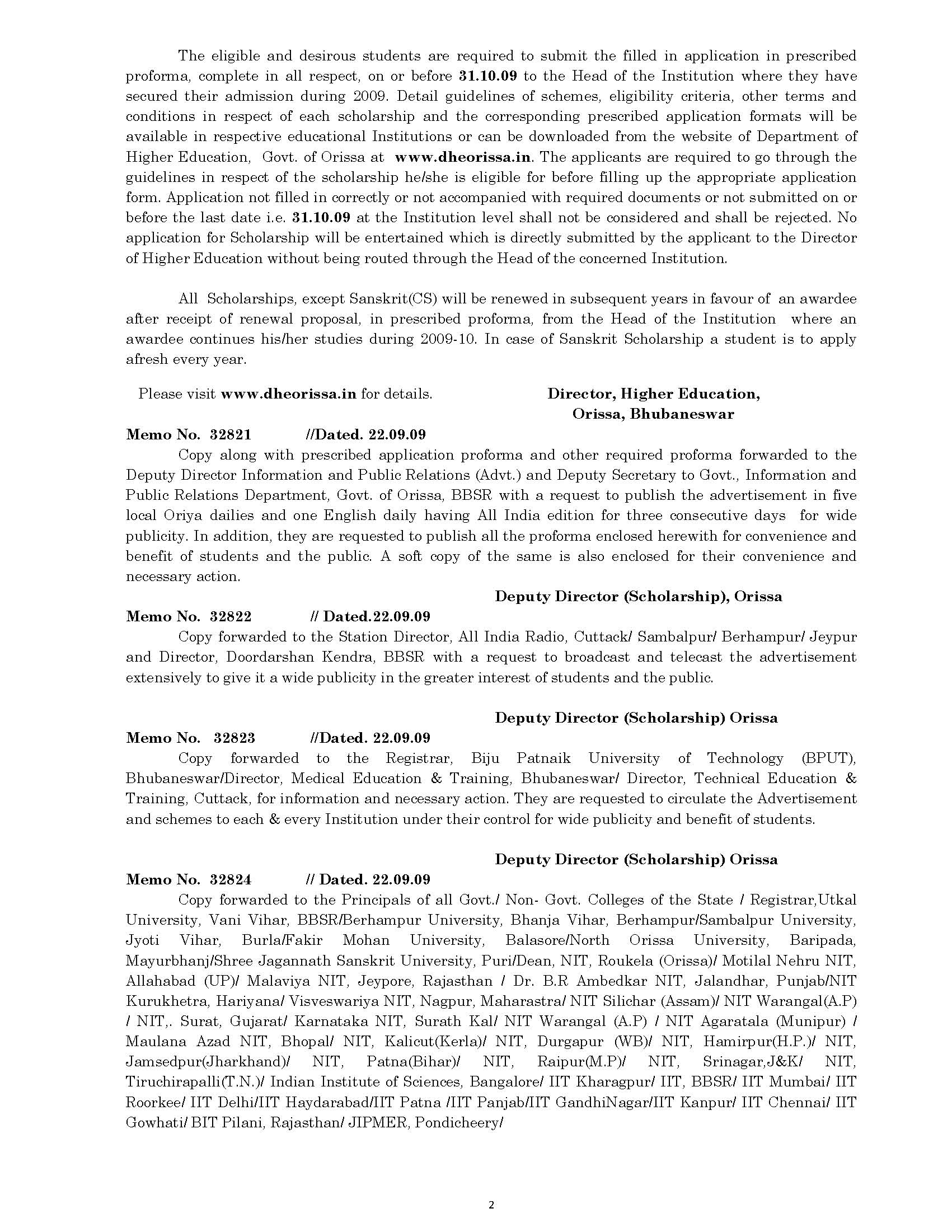
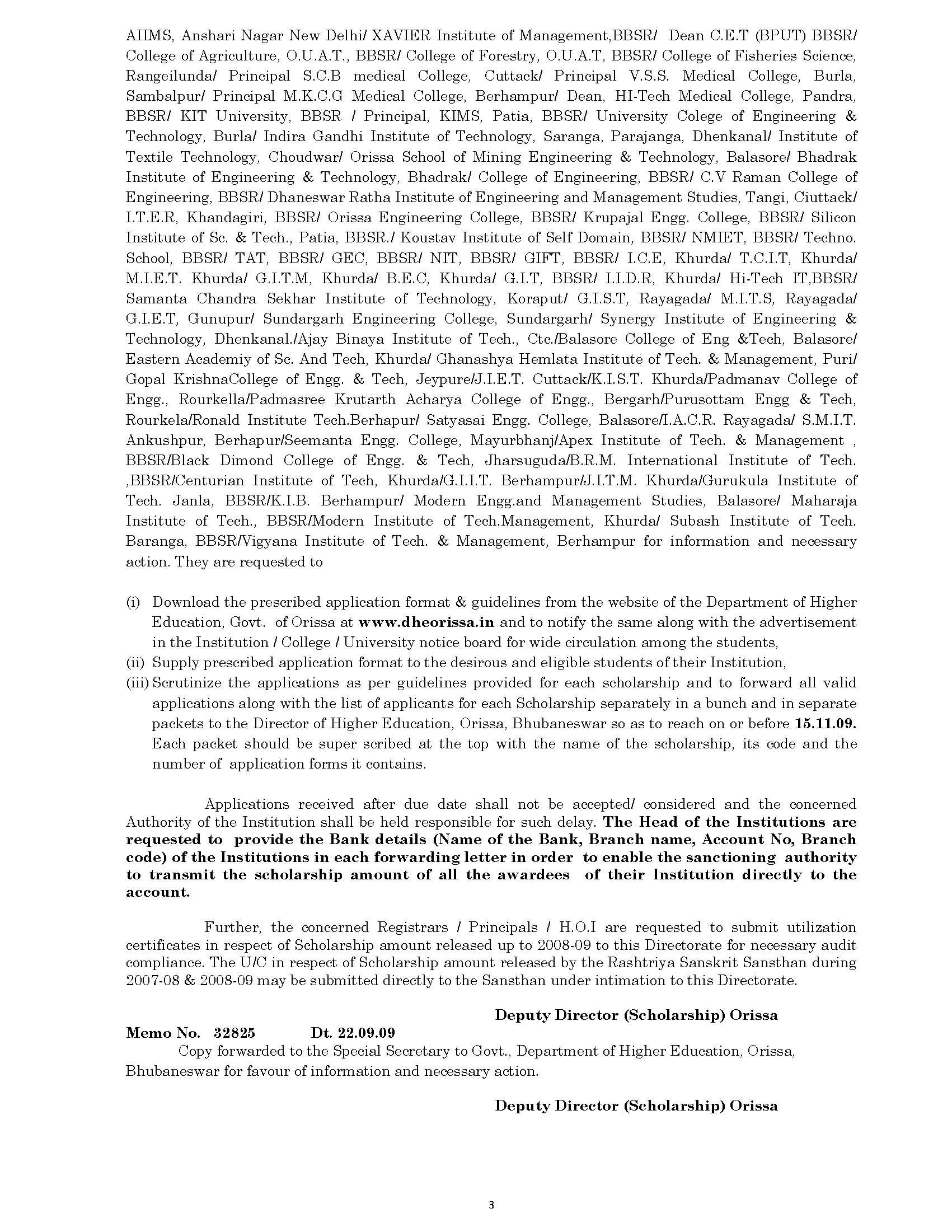
September 24th, 2009
Pioneer reports on a letter written by Sanjib Karmee about establishing a central university in the Western part of Orissa. Following are some excerpts.
.. One such letter written to the Prime Minister, President and other top political leaders of the country including one to the Chief Minister of Orissa and members of Parliament, by Dr Sanjib Kumar Karmee of Bio-catalysis and Organic Chemistry group of the Delft University of Technology, The Netherlands, has made a fervent appeal to the powers that be to open a Central University in the Koshal region.
He has appreciated the efforts of Ministry of Human Resources and other Central Government ministries in the establishment of many centrally funded institutions in Orissa keeping the backwardness of the State in mind.
He has cited that the current Government of the State is adopting a capital centric approach, clustering Bhubaneswar with National Institute of Science Education and Research (NISER), Indian Institutes of Technology (IIT), All India Institute of Medical Sciences (AIIMS), and Railway Medical College.
The State Government has chosen only two such centrally funded institutes outside Bhubaneswar-Cuttack-Puri region of having a Central University at Koraput in south Orissa and a proposal to set-up the Indian Institute of Information Technology in Berhampur which is also in south Orissa.
Koshal region he writes is one of the most backward regions in Orissa, and has demanded the establishment of centrally funded institutes in Koshal region. At the same time he writes about the connectivity and amenities of the region which has infrastructural readiness to have a Central University, besides he says the region has two universities – Sambalpur University and VSS University of Technology – a Government Medical College, and a few private engineering colleges. Rourkela city which is close to Burla-Sambalpur-Jharsuguda area has a National Institute of Technology at Rourkela. On connectivity he writes there is a proposal by the Government of India to have an airport at Jharsuguda and further that Jharsuguda is well connected by rail to the various States in India. Burla-Sambalpur-Jharsuguda area is emerging as a central location for on going industrial activities in the region.
Since MHRD is very serious about increasing the GER, I think the 12th plan would include some more central universities (or at the worst case universities that are funded 50-50 by center and state). Also, as I mentioned earlier, many states have regions which have been left out of the national university (mostly went to the state capital or the 1st or 2nd most populated metro area of the bigger states; but all went to metro areas with a population of greater than 1 million; the obvious reason seems to be the vision behind these universities as stated in the first announcement as well as in the concept papers) and first central university distributions (many went to smaller places of the states), and they would like to have a central university/institution. This includes Nagpur in Maharastra, Kadapa in Andhra Pradesh, Durgapur/Asansol/Siliguri in West Bengal, Bhawanipatna/Jharsuguda/Rourkela in Orissa etc.
In Orissa, after CUO Koraput and national university in Bhubaneswar, the government should strongly consider a location in its Western part (and far from Bhubaneswar) for that. Among the possible locations, a sentimental favorite would be Bhawanipatna, as it has been reported that at one point the CM had assured the representatives from Kalahandi regarding locating the first central university there. Other good locations could be Rourkela (a bit in the corner though; but is a metro and has a sizable population and does not have a regular university; it does have NIT) and Jharsuguda (lots of industrial development happening here, not too far from Rourkela, but close to Sambalpur which has two universities; But Jharsuguda itself has nothing and is going to have an airport soon).
September 24th, 2009
Next Posts
Previous Posts



